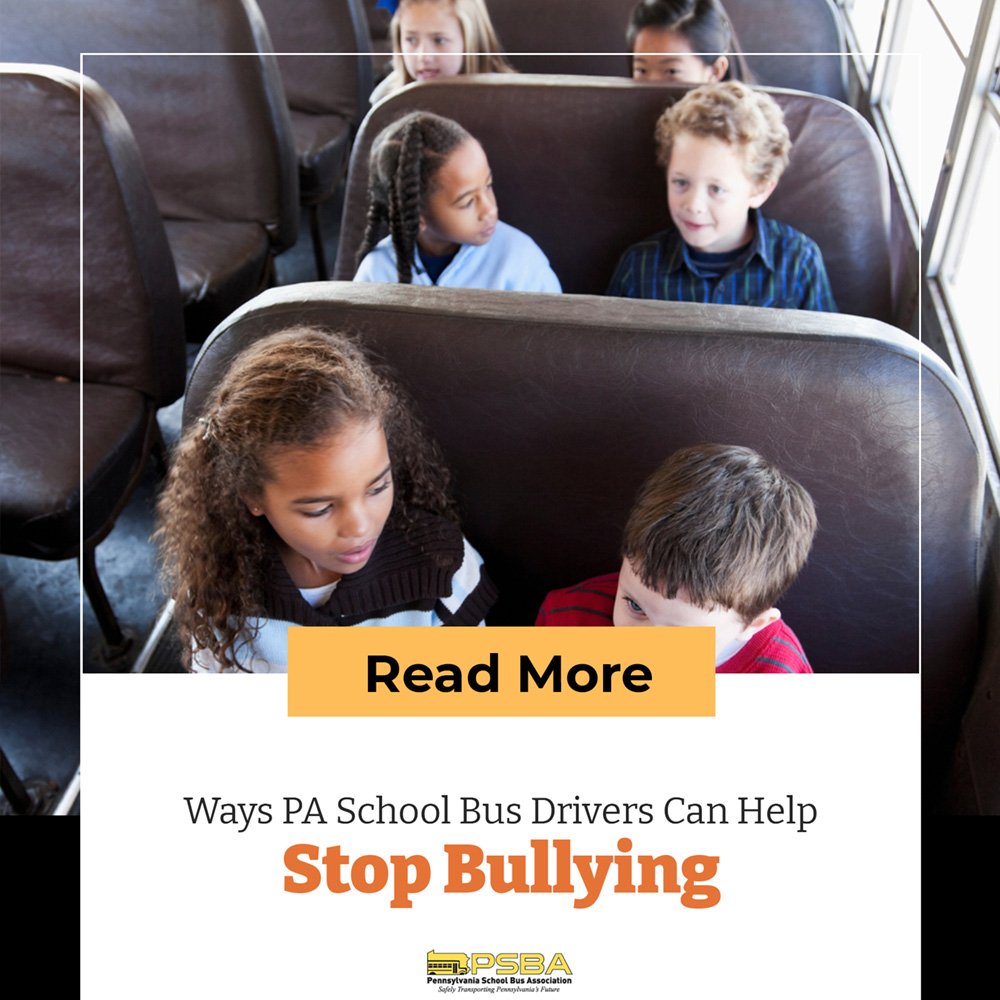Bullying is a fundamental problem in most schools. The sad reality is that there’s a chance that a kid gets bullied. Even sadder, many of these bullying incidents go unnoticed or unreported.
Bullying doesn’t only happen in the classroom. It can also occur at the school playground, canteens, and restrooms. It can happen on the school bus, too. As someone in charge of the students on the bus, PA school bus drivers have a legal and ethical responsibility to ensure the children feel safe and welcome on the bus.
Many schools impose anti-bullying rules and laws framed to prevent bullying that happens while at school or on the school bus. One of every five (20.2%) students reports they have been bullied.
Bullying can take several forms, such as:
- Physical (hitting, beating, punching)
- Verbal (teasing, name-calling, threats)
- Emotional (threats, intimidation, social exclusion)
- Sexual
- Racist bullying
- Cyberbullying (online threats, online harassment, hate messages, impersonation, and other online and digital abuse)
- Hazing
NOTE: children with disabilities may have a higher risk of being bullied.
Having communication skills is one of the essential traits of a good school bus driver. Being a trustworthy figure, that students, teachers, and parents rely on is vital. When students trust you enough, they won’t hesitate to tell you they are being bullied (or have seen a friend or another student being bullied).
With open communication, it is possible to know whether a child is being bullied or not. Unfortunately, many students hide they are being bullied in a school environment, in the classroom, or on the school bus.
So, as a school bus driver, how can you tell that a student is being bullied on the bus? How can you stop it?
School children being picked on aren’t always comfortable telling others about it or feel ashamed of asking others for help. But if you have something called “parent’s intuition,” you can easily pick up signs that your child is being bullied.
A child who appears quiet or uncommunicative may be a sign. Or they may seem moody, anxious, teary, or depressed as they get on or off the bus. You may not suspect that something is wrong until your child starts coming up with excuses not to take the school bus or avoid going to school altogether. Those are warning signs that a child might be bullied.
Have you noticed that your child may get on and off the bus with torn, damaged, or missing parts of their clothing, books, or other belongings? It can also be a warning sign of bullying and abuse. If your child has unexplained scratches, cuts, and bruises on their face and body, consider them red flags that should be addressed immediately.
Bullying can also cause stress-related physical symptoms in your child. They may frequently complain of headaches, stomachaches, dizziness, nausea, or other physical ailments. Please realize that these children don’t have conscious control over these symptoms, and they’re not pretending or making these things up.
Many school children don’t report bullying because they are afraid. They worry that it will lead to retribution or more bullying if they do so. Sometimes, younger schoolchildren may not recognize such acts as bullying or don’t know what to call them. Of course, some bullies will threaten other kids about what can happen to them if they tell their bullying to someone else.
Bullied children may have few friends with whom they spend their time. It’s good to ask them directly, but straightforward questions like, “Do you have friends in school?” or “How are the other kids in school?” It will compel kids to answer your questions about how they are being treated by the other kids (or sometimes, teachers, principals, or others from the school staff). Their answers can provide you with some helpful clues.
It’s also important to keep in constant touch with the school authorities. Ask the teacher how their students do in school, how active they are, and how the other children are treating them.
If bullying happens on the school bus, support the school authorities to deal with the issue. It’s also good to provide emotional support to the bullied child and tell them that they don’t deserve it, and you will be there to help them in any way you can.
It’s an adult’s job to keep the children safe. But as a bus driver, you cannot constantly monitor or intervene, especially if the bullying happens outside the school bus or when you’re focused on the road. Even though you would stand up for them, it is also essential for them to learn to stand up for themselves. Teach your child to be proactive to learn to be bolder and more assertive without being offensive.
If your child isn’t a direct victim but has witnessed another student being bullied on the bus, you can still help them report the bullying behavior to the school authorities. Depending on their age, condition, or situation, children who see the bullying on the bus may feel hesitant to get involved. But as a bus driver, you can encourage children to speak up if they witness the bullying on the school bus. Speaking up can have a significant effect because bullies often back off when someone calls out their behavior. It’s also imperative to have conversations with your child and tell them that it’s never okay to join in on the bullying.
School buses are extensions of the school environment, so they’re likely covered in your school’s anti-bullying policies. As PA school bus drivers, there are many rewards to the job. Learning about your school’s bullying prevention policies is also a part of your duty to make sure that the children feel safe while they’re on the school bus.
If you are interested in becoming a PA school bus driver, check out the available positions at https://schoolbushero.com/jobs.

